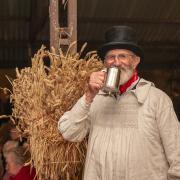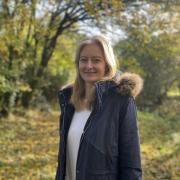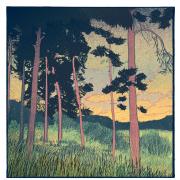With a good horse, Thomas Baskerville said, a man could travel 50 miles in a day. He can be believed – he went on a long journey every few years. He was not wealthy enough to own a coach, but rode on horseback through many English counties, starting from his home just across the Gloucestershire border. He lived in Stanton Harcourt, and after his father's death in Bayworth manor house in Sunningwell, then in Berkshire, now in Oxfordshire. He kept notes of where he went, and wrote up his journeys in the 1680s, intending to publish them together with other varied writings. He commissioned an engraving of himself to be the frontispiece, published in 1700 as a semi-satirical broadsheet, the year of his death, but his writings remained unpublished.
Baskerville was obviously a sociable man, enjoying a glass of wine though critical of the quality, and careful about the source of the water supply before he drank ale. In Winchcombe the landlord of the Bell inn, Mr Houlet and his wife had 'verry good water in their well' and so provided good Ale. He probably visited Winchcombe in 1682, though he rarely dated his journeys, noting the fair on July 17 ‘to which many good horses are brought to be sold,’ but on the other hand in Cheltenham he said ‘abundance of horses for the cart and other drudging uses but few for the saddle’ were sold at the St James's day great fair.
Baskerville probably traversed the Cotswolds on many occasions, visiting places associated with his family; he was related to the Huntley family of Boxwell, to the Throckmortons of Clowerwell or Clearwell and Tortworth, and the Scudamores of Holme Lacy in Herefordshire. He also visited his many friends. After one journey he reflected:

‘here it may not be amisse to speake somewhat in generall of thes Cotswould or highland Countryes which contribute such pleasure to Travellers in length and breadth stretching many miles, for we are long and steal up so gently e'er we obtain their highest summets we cannot but wonder when we come there, how we should get so much above another world, full of people and great riches under us, such are the aluring prospects you find at Sir Gabriel Low's house and at Simon's hall Tump hard by Mr Veal's house the highest land about all these parts.’
Sir Gabriel Lowe's house was Newark in Ozleworth, and Thomas Veel’s at Simon’s Hall in Wotton-under-Edge. Coming from the east, Baskerville rode up the gentle dip slope of the Cotswolds. Clearly this 17th-century gentleman appreciated a ‘prospect’, and it is notable that he suggested the pleasure of travelling across the Cotswolds was not peculiar to himself but a general experience.
Still, they could be daunting, if travelling in the dark and fog. A party of four gentlemen and three men servants went to Coberley to buy colts from Mrs Castleman. She had been widowed some years; her husband had broken his neck with a fall from his horse while coursing. Baskerville commented that his portrait showed him to have been a very handsome man. It was not the only horse-riding accident he reported; they were one cause of male mortality perhaps not usually considered. Whether Baskerville's party bought some colts was not recorded, but he said they were well entertained. Thinking that seven men with their horses was too large a group to accept overnight hospitality at Coberley Manor, they decided to head to the Frogmill Inn in Shipton Solers.

Mrs Castleman's man showed them the way to within half a mile of Coldcomfort inn and a mile of the Frogmill. They had perhaps been entertained too generously, because after the man left them, they turned right instead of left. After riding over the Cotswolds for some 5 miles, they found themselves ‘shut up in the darkness upon these comfortless downs, where I knew wee might ride 20 miles forward and perhaps not find a house.’ Luckily, they met someone who directed them to Chedworth and thence to Withington and the George inn. Here they were cheered with fried beef, good fires, excellent ale, well-roasted birds which they had shot (shooting sea meaws was described on a previous journey), followed by a good breakfast and oats for the horses, the whole costing a modest 17 shillings. The experience at the George stayed in Baskerville's memory and he referred to it on another occasion.
Happily, the ride from Winchcombe to Cheltenham was more pleasing. Baskerville went to Postlip, noting the chapel beside the house, and then uphill over the old road to the summit of Cleeve Hill. His description is a powerful indication that a 17th-century traveller had a sense of landscape.
'From the top of this high and aery becon hill the prospects are soe alluring and intermingled with soe much variety, that as a man may say it may be like that with which the devill did tempt Christ, a shew of the glory of the world and its riches. (viz.) great cities and Towns, and a plentifull country under you, for as you travell this ridg country way, here you see Glocester there Worcester, here Teuxbury and there Easome [Evesham] with many more eminent places.'
What would he think today with the growing number of new houses in the view? He wrote about his appreciation of other views, for example from Bredon hill, and indeed praised the situation of his own home because of its hills and views.
Many places attracted brief but telling comment from Baskerville. An exploration in verse (it cannot be described as poetry) of rivers rising in the Cotswolds and flowing into the Thames contains many interesting observations. He had visited places along the Coln, the Leach and the Windrush. He admired the sweet garden in Cassey Compton 'Where maidens may wash and cleanse their feet'. With his interest in springs of water, he had been told about the great spring in Syreford in Whittington, and 'at Compton in the hole in the road from hence to Norlidg [Northleach] other springs doe rise in the high way which joyn wih those above said at Withington'.

Thomas Basskerville’s prose writings and his verse contain many such vignettes, now published in a collected edition, Thomas Baskerville: Journeys in Industrious England and writings personal and topographical (Hobnob Press, 2023).



























